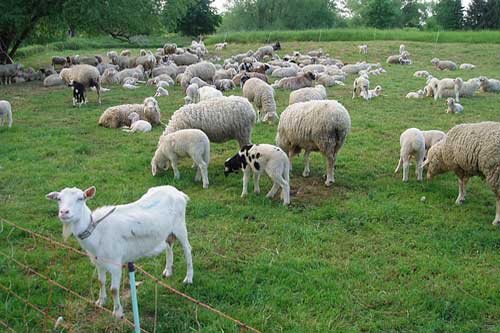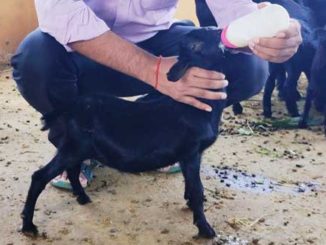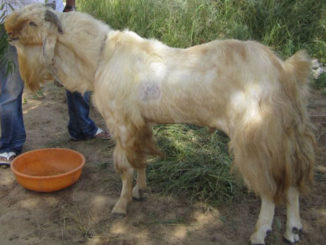Introduction
Livestock sector is one of the important sources of income and employment to rural people. Both livestock and agriculture are very much dependent on each other. The livestock products are likely to grow at a faster rate. About 70 per cent of the landless agricultural labourers, marginal and small farmers in the country are associated with goat husbandry. Small ruminants play an important role in Indian economy and it provides livelihood to two-third of rural community. In India sheep and goat make a valuable contribution to the livelihood of the economically weaker sections of the society. There are around 223 MN small ruminants. They add around 24, 000MN every year to the rural economy. Agriculture provides livelihood support for more than 58 percent people in the country. The major source of returns in sheep rearing was from sale of the animals in all the rearing methods, followed by sale of lambs, value of home consumption, penning and manure. The major source of returns in goat rearing was from sale of the animals, followed by sale of lambs, value of home consumption, penning and manure.
Contribution of small ruminants
Small ruminants are essential component of rainfed farming systems in semi-arid India. Two models of sheep rearing, lamb fattening and breed multiplication were promoted as a source of income generation and self-employment for the poor and landless households.
The lamb fattening sheep unit represents a very reasonable livelihood option for agricultural labourers as it requires less resources and not demand very specialized skills. The breeding unit, which requires the part time involvement of the farmer, or his family member, provides a very stable and attractive additional income source for small and marginal farmers without affecting their main occupation.
Rearing of sheep and goats plays an important role in the economy of India in general and sustainable livelihood of poor people of rainfed agro-ecosystem in particular, because of inherent risk involved in the crop farming due to uncertainty of rainfall and occurrence of recurrent droughts. They are raised mainly for meat, milk, and skin and providing a flexible financial reserve (social security) in bad crop years for the rural population. They also play a significant role in the livelihood of small, marginal farmers and landless rural people. They add around 24, 000 million every year to the rural economy because about 6 million families in India are engaged in various activities relating to rearing of small ruminants.

The majority of the poor people select sheep rearing for improving their livelihood mainly because of easy maintenance and availability of ready-made market round the year. Sheep were preferred over goats as they could graze on the dry grass, twigs and crop residues even during peak summer months. Further, people prefer local breed as they are more resistant to diseases compared to crossbreds.
Sheep husbandry is one of the important sources of income and livelihood among the farmers in the state of Telangana, Andhra Pradesh, Karnataka, Tamil Nadu, Himachal Pradesh, Jammu & Kashmir, Rajasthan and Uttrakhand. As per the latest livestock census, sheep population has increased from 65.06 million to 74.26 million, contributing 678.0 million kg of mutton, 40.4 million kg of wool and employment to nearly 6 million people. The country is importing 80-90 million kg of wool from Australia, New Zealand and other countries. The production levels in these two categories have been almost constant at 0.95 million tons with annual exports of less than 10,000 tons. Farmers are being benefited from the various scheme like Tribal sub plan, Schedule caste sub plan, Farmer FIRST, Mera Gaon Mera Gaurav, Sansad Adarsh Gramin Yojna etc.
NAIP aimed at testing a new model of sustainable rural livelihood (SRL) strategy, which is focused on innovations in technology transfer, support systems and collective action with the overall goal of improving the income and livelihoods of people.
Goats play an important role in the food and nutritional security of the rural poor especially in the rainfed regions where crop production is uncertain, and rearing large ruminants is restricted by acute scarcity of feed and fodder. Goat rearing has distinct economic and managerial advantages over other livestock because of its less initial investment, low input requirement, higher prolificacy, early sexual maturity, and ease in marketing. Goats can efficiently survive on available shrubs and trees in unfavourable environments. In pastoral societies in India, goats are kept as a source of additional income and as an insurance against income shocks of crop failure. Efforts should be made by both research and development institutions to link up rural poor/women with funding agencies. Rearing sheep requires less resource and is appropriate where capital is scarce.
Sheep rearing can provide part time self-employment without affecting the main occupation for small and marginal farmers. Sheep rearing is an enterprise that does not demand very special skills compared to other agricultural enterprises. The rural poor who cannot afford to maintain a cow or a buffalo find goat as the best alternative source of supplementary income and milk. Unlike a cow or buffalo, a few goats can be maintained easily and can be easily liquidated in times of distress.
In India Sheep make a valuable contribution to the livelihood of the economically weaker sections of the society. Sheep and Goat are two important livestock varieties in India, especially in areas where crop and dairy farming are not economical and play an important role in the large proportion of the livelihood of the small and marginal farmers. In 2018-19, the erstwhile Department of Animal Husbandry, Dairying & Fisheries has introduced a scheme named Rural Backyard Development Programme Goats provide livelihood support to landless, marginal, and small farm households. Because of low investment costs, high fecundity, easy marketing, and social acceptance of goat meat, goat farming is an ideal livelihood option for the underprivileged rural households. Women play major role in management of small ruminants, particularly goats. They get an opportunity to assimilate some income that leads to savings. The benefits of rearing small ruminants are its low initial capital investment, low operational cost, immediate returns because of short gestation period and high level of prolificacy.
Constraints faced by goat farmers
- Absence or Weak Livestock keeper Organizations – Relatively weak public support institutions for credit, animal health and production inputs
- Transportation & Diseases– certain outbreak of diseases causes huge losses of farmers
- Breeding stock and its breeding
- Availability of inputs and services
- Marketing
- Reduced access to credit and insurance
- Inadequate grazing resources
Conclusion
Small ruminants provide subsistence to rural population, leads to poverty reduction and contributes to Indian economy. The sector till now has been neglected and unorganized. Streamlining the sector and addressing issues related to small ruminant sector development is the need of the hour. It is necessary to strengthen research, educate farmers, transfer technology, and improve goat health for making the commercial goat production economically viable and sustainable. A successful livestock value chain (VC) support is imperative to not only help meet growing demands and standards of meat and dairy products but also leads to poverty reduction, especially for small-scale livestock keepers. The lamb fattening sheep unit represents a very reasonable livelihood option for agricultural labourers as it requires less resources and not demand very specialized skills. The breeding unit, which requires the part time involvement of the farmer, or his family member, provides a very stable and attractive additional income source for small and marginal farmers without affecting their main occupation.






Be the first to comment